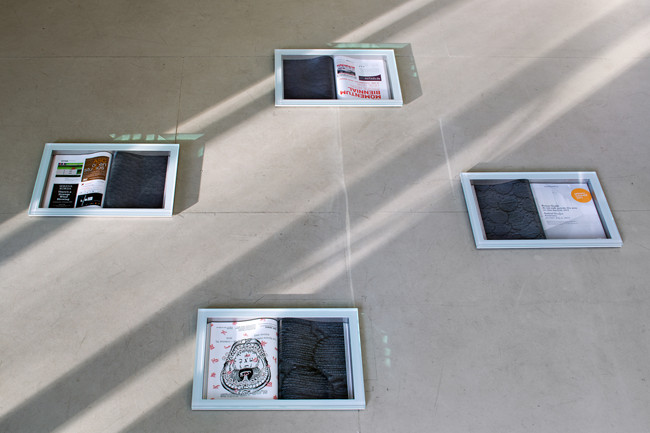Aldo Runfola
08 Nov 2014 - 10 Jan 2015
ALDO RUNFOLA
Monuments
8 November 2014 - 10 January 2015
Can a magazine work like a smart phone? That seems to be one of the ideas behind Aldo Runfola's FRIEZE PROJECT (2010-13). Over the last few years, the artist took out full page adverts, which show illustrations of his embroidery works: far away and close-up. With these enlargements and reductions, Runfola effectively made the magazine page somehow akin to a touch screen, in particular, the screen's haptic functions: light hand gestures that make a photograph smaller or larger. Here, as we flip paper pages, from one issue to the next, our fingers move into and out of Runfola's image. Closer and further away.
Of course, most magazines have website doubles, which echo each other, either faintly or completely. Yet the two technologies – analogue print and digital mobility – couldn't be more distinct. The NSA cannot track you perusing paper, nor can a traditional book amass statistics about how quickly you and other readers around the world are turning the pages, as e-books now do. Runfola's monuments seem to question both analogue and digital ways of belonging, from the traditional collectivities of the nation-state (shared citizenship) to the new digital publics customized by a touch to the screen (followers, hits, shares, likes). Artworks – along with the embodied aesthetic experience of them – should form this bond, linking us to each other.
Runfola's medium – embroideries he had made in Morocco – reinforce a tactile collective bond between the artist, the fabricators, the magazine readers and the gallery visitors. The works are not only visually but also haptically shared, even when they are turned into images: from the embroiders, pulling threads, to the viewers, turning pages. While Kantian taste has long linked and divided us on matters of art and culture, perhaps touch could be a new and politicized form of distinction.
Dr. Jennifer Allen, lives in Berlin
Monuments
8 November 2014 - 10 January 2015
Can a magazine work like a smart phone? That seems to be one of the ideas behind Aldo Runfola's FRIEZE PROJECT (2010-13). Over the last few years, the artist took out full page adverts, which show illustrations of his embroidery works: far away and close-up. With these enlargements and reductions, Runfola effectively made the magazine page somehow akin to a touch screen, in particular, the screen's haptic functions: light hand gestures that make a photograph smaller or larger. Here, as we flip paper pages, from one issue to the next, our fingers move into and out of Runfola's image. Closer and further away.
Of course, most magazines have website doubles, which echo each other, either faintly or completely. Yet the two technologies – analogue print and digital mobility – couldn't be more distinct. The NSA cannot track you perusing paper, nor can a traditional book amass statistics about how quickly you and other readers around the world are turning the pages, as e-books now do. Runfola's monuments seem to question both analogue and digital ways of belonging, from the traditional collectivities of the nation-state (shared citizenship) to the new digital publics customized by a touch to the screen (followers, hits, shares, likes). Artworks – along with the embodied aesthetic experience of them – should form this bond, linking us to each other.
Runfola's medium – embroideries he had made in Morocco – reinforce a tactile collective bond between the artist, the fabricators, the magazine readers and the gallery visitors. The works are not only visually but also haptically shared, even when they are turned into images: from the embroiders, pulling threads, to the viewers, turning pages. While Kantian taste has long linked and divided us on matters of art and culture, perhaps touch could be a new and politicized form of distinction.
Dr. Jennifer Allen, lives in Berlin

